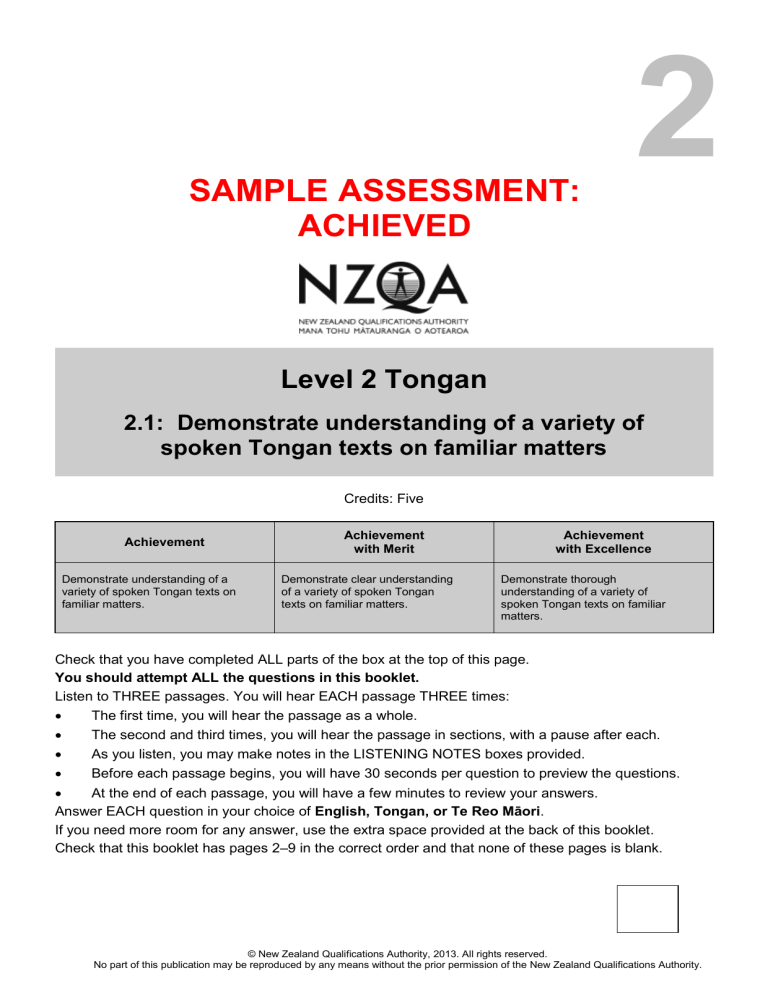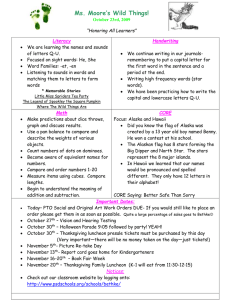
SAMPLE ASSESSMENT:
ACHIEVED
2
Level 2 Tongan
2.1: Demonstrate understanding of a variety of
spoken Tongan texts on familiar matters
Credits: Five
Achievement
Demonstrate understanding of a
variety of spoken Tongan texts on
familiar matters.
Achievement
with Merit
Demonstrate clear understanding
of a variety of spoken Tongan
texts on familiar matters.
Achievement
with Excellence
Demonstrate thorough
understanding of a variety of
spoken Tongan texts on familiar
matters.
Check that you have completed ALL parts of the box at the top of this page.
You should attempt ALL the questions in this booklet.
Listen to THREE passages. You will hear EACH passage THREE times:
The first time, you will hear the passage as a whole.
The second and third times, you will hear the passage in sections, with a pause after each.
As you listen, you may make notes in the LISTENING NOTES boxes provided.
Before each passage begins, you will have 30 seconds per question to preview the questions.
At the end of each passage, you will have a few minutes to review your answers.
Answer EACH question in your choice of English, Tongan, or Te Reo Māori.
If you need more room for any answer, use the extra space provided at the back of this booklet.
Check that this booklet has pages 2–9 in the correct order and that none of these pages is blank.
© New Zealand Qualifications Authority, 2013. All rights reserved.
No part of this publication may be reproduced by any means without the prior permission of the New Zealand Qualifications Authority.
2
Ngāue‘aki ‘a e houa ‘e taha ke tali ‘a e ngaahi fehu‘i ‘i he pepa ni.
You are advised to spend one hour answering the questions in this booklet.
FIRST PASSAGE: Ko ‘Auka mo Malama
Fanongo lelei ki he talanoa ‘o ‘Auka mo Malama.
Listen to the story about ‘Auka and Malama.
Ko e fehu‘i ‘uluaki (Konga A mo e Konga B) ‘oku fakatefito ia ‘i he konga tohi ko eni. ‘Oku ‘oatu
‘a e sekoni ‘e 30 ke ke lau ai ‘a e fehu‘i he taimi ni.
Question One (Section A and Section B) is based on this passage. You now have 30 seconds to
read the question.
FEHU‘I ‘ULUAKI – QUESTION ONE
Ngāue‘aki ‘a e Konga A ke tali ‘a e Fehu‘i ‘Uluaki (a).
Use Section A to answer Question One (a).
(a) Ko hai e tangata na‘e loto ‘a e fa‘ē ‘a Malama ׳ke mali mo Malama?
Who is the young man that Malama’s mother wants Malama to marry?
Hingoa / Name: Koli, or Koli Tala‘aho
Ko e hā e ‘uhinga ne loto ai e fa‘ē ‘a Malama ׳ke mali ‘a Malama mo e tangata?
Explain why Malama’s mother wants Malama to marry the young man.
‘Uhinga / Reason
Malama’s mother wants Malama to marry Koli because Koli has money and can look after
her.
Ngāue‘aki ‘a e Konga B ke tali ‘a e Fehu‘i ‘Uluaki (b).
Use Section B to answer Question One (b).
(b) Ko hai ‘oku ‘uhinga ki ai e fo‘i laine ko eni, “‘Oku ne mātā ho fofonga he ‘aho kotoa pē,” ‘i he
maau?
To whom does the line “‘Oku ne mātā ho fofonga he ‘aho kotoa pē” refer in the poem?
Hingoa / Name: Mohokoi flower(s)
Ko e hā hono ‘uhinga ho‘o tali?
Give a reason to support your answer.
‘Uhinga / Reason
Because it says that happy are the sweet mohokai flowers by your yard who can gaze at
thy face.
Tongan 2.1 Sample assessment: Achieved
Ke
ngāue‘aki
pē ‘e he
fai sivi
Assessor’s
use only
3
Ke
ngāue‘aki
pē ‘e he
fai sivi
Assessor’s
use only
LISTENING NOTES
Tongan 2.1 Sample assessment: Achieved
4
SECOND PASSAGE: Founga ke ako ki he sivi
Fanongo lelei ki he fakamatala ki he ‘Founga ke ako ki he sivi’.
Listen to the text ‘How to study for an exam’.
Ko e Fehu‘i Ua ‘oku fakatefito ‘i he konga tohi ko eni. ‘Oku ‘oatu ‘a e sekoni ‘e 30 ke lau ai ‘a e
fehu‘i he taimi ni.
Question Two is based on this passage. You now have 30 seconds to read the question.
FEHU‘I UA – QUESTION TWO
Ngāue‘aki ‘a e Konga A ke tali ‘a e Fehu‘i Ua (a).
Use Section A to answer Question Two (a).
(a) ‘Omai ha ‘uhinga ‘e tolu ‘oku mahu‘inga ai ke palani pea fa‘u ha taimi tēpile ako ki he teuteu
sivi.
Give three reasons why it is important to create a study timetable when preparing for exams.
‘Uhinga 1 / Reason 1
To ensure that you study all the topics covered in the exam.
‘Uhinga 2 / Reason 2
To avoid last-minute cramming.
‘Uhinga 3 / Reason 3
To spend enough time on difficult subjects without fretting.
Ngāue‘aki ‘a e Konga B ke tali ‘a e Fehu‘i Ua (b).
Use Section B to answer Question Two (b).
(b) Tohi mai ha lelei ‘e tolu ‘oku ma‘u mei he‘ete ako mo tohitohi.
Give three benefits of rewriting notes when studying for exams.
Lelei 1 / Benefit 1
You will probably think more about what you are writing.
Lelei 2 / Benefit 2
Refreshes your memory.
Lelei 3 / Benefit 3
Saying the answers to your questions out loud.
Tongan 2.1 Sample assessment: Achieved
Ke
ngāue‘aki
pē ‘e he
fai sivi
Assessor’s
use only
5
Ngāue‘aki ‘a e Konga C ke tali e Fehu‘i Ua (c).
Use Section C to answer Question Two (c).
(c) ‘Oku ke tui ‘oku lelei ‘a e ako lōloa mo ta‘emotu ‘i he teuteu sivi?
Do you think it is a good thing to study for long hours when preparing for an exam?
‘Io (Yes) / ‘Ikai (No)
No
‘Omai ha ngaahi ‘uhinga mei he konga tohi ne lau ׳ke poupou‘i‘aki ho‘o tali.
Give reasons from the text to support your answer.
You won’t remember much, and you’re likely to see a drop in your performance the next
day.
LISTENING NOTES
Tongan 2.1 Sample assessment: Achieved
Ke
ngāue‘aki
pē ‘e he
fai sivi
Assessor’s
use only
6
THIRD PASSAGE: Folau ‘Eve‘eva
Ke
ngāue‘aki
pē ‘e he
fai sivi
Assessor’s
use only
Fanongo lelei ki he fakamatala fekau‘aki mo e Folau ‘Eve‘eva.
Listen to the passage about tourism.
Ko e Fehu‘i Tolu ‘oku fakatefito ‘i he konga tohi ko eni. ‘Oku ‘oatu ‘a e sekoni ‘e 30 ke lau ai ‘a e
fehu‘i he taimi ni.
Question Three is based on this passage. You now have 30 seconds to read the question.
FEHU‘I TOLU – QUESTION THREE
Ngāue‘aki ‘a e Konga A ke tali e Fehu‘i Tolu (a).
Use Section A to answer Question Three (a).
(a) ‘Omai ha ngaahi lelei ‘e fā ‘oku ma‘u ‘e he Pule‘anga mei he Folau ‘Eve‘eva. Tohi mai ho‘o
tali ‘i he ngaahi puha ‘i he fakatātā ‘oku ‘oatu ‘i lalo׳.
Give four benefits that the government might get from tourism. Write your answers in the boxes
in the diagram below.
Government receives a
certain amount as tax
Provide medical services
Ngaahi lelei ‘oku
ma‘u ‘e he
Pule‘anga mei he
Folau ‘Eve‘eva
Building schools
Building roads and wharves and
government offices
Tongan 2.1 Sample assessment: Achieved
7
Ngāue‘aki ‘a e Konga B ke tali ‘a e Fehu‘i Tolu (b).
Use Section B to answer Question Three (b).
(b) ‘Omai ‘a e palopalema ‘e fā ‘oku fakatupu ‘e he Folau ‘Eve‘eva. Tohi mai ho‘o tali ‘i he
ngaahi puha ‘i he fakatātā ‘oku ‘oatu ‘i lalo׳.
Give four problems that the Pacific Islands might get from tourism. Write your answers in the
boxes in the diagram below.
Many hotels may not be able to
make a profit
Not all the money stays in that
country. Much of it flows out of
the country in payment for
goods imported.
Ngaahi palopalema
‘oku ma‘u mei he
Folau ‘Eve‘eva
Tourism has an effect on
cultures and traditions
People may lose their jobs
LISTENING NOTES
Tongan 2.1 Sample assessment: Achieved
Ke
ngāue‘aki
pē ‘e he
fai sivi
Assessor’s
use only
8
Konga ‘oku ‘atā ‘o ka fiema‘u.
Extra space if required.
Tohi ‘a e fika ‘o e fehu‘i ‘o ka fiema‘u.
Write the question number(s) if applicable.
Fika ‘o e
fehu‘i
Question
number
Tongan 2.1 Sample assessment: Achieved
Ke
ngāue‘aki
pē ‘e he
fai sivi
Assessor’s
use only
9
Konga ‘oku ‘atā ‘o ka fiema‘u.
Extra space if required.
Tohi ‘a e fika ‘o e fehu‘i ‘o ka fiema‘u.
Write the question number(s) if applicable.
Fika ‘o e
fehu‘i
Question
number
Tongan 2.1 Sample assessment: Achieved
Ke
ngāue‘aki
pē ‘e he
fai sivi
Assessor’s
use only






